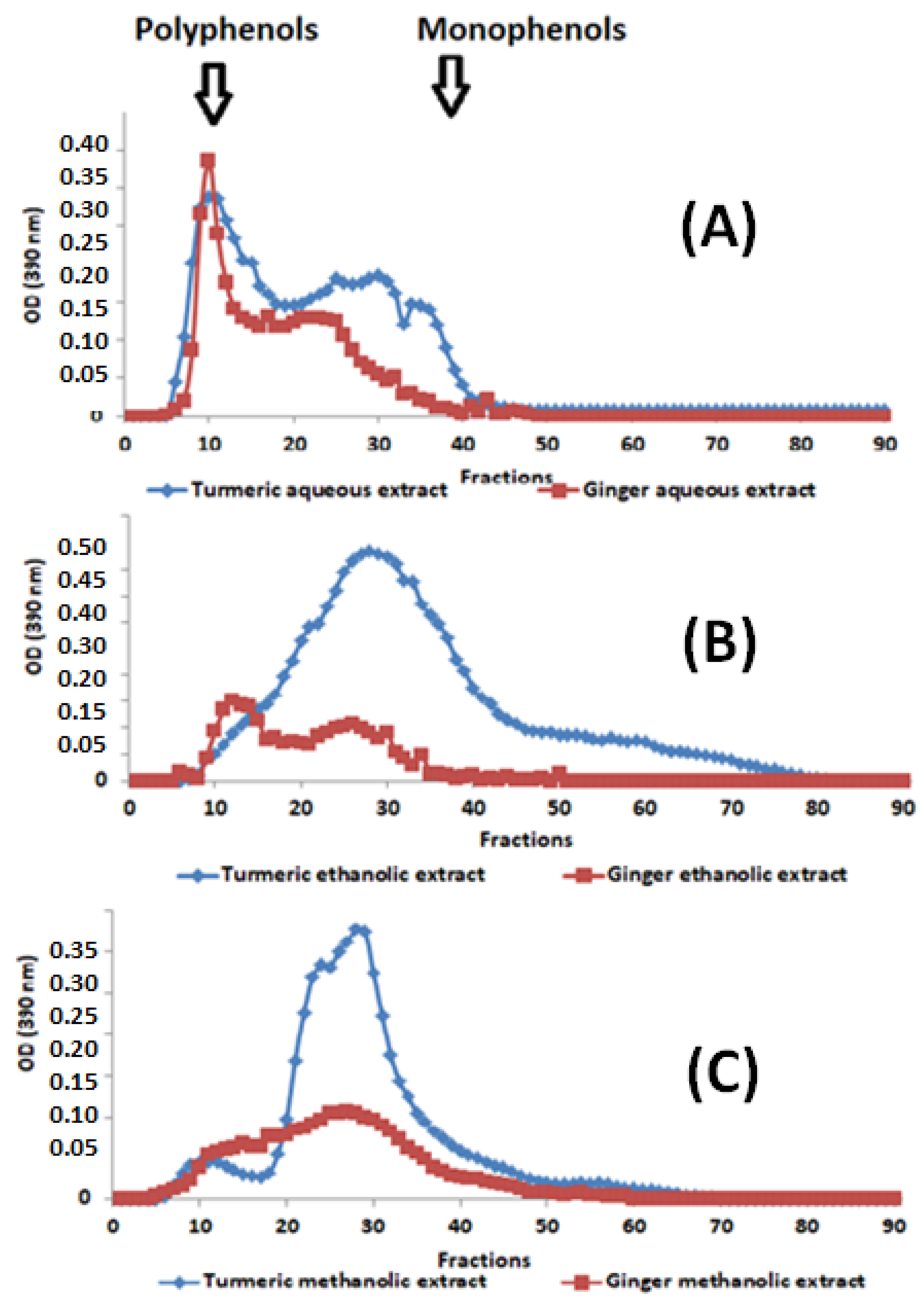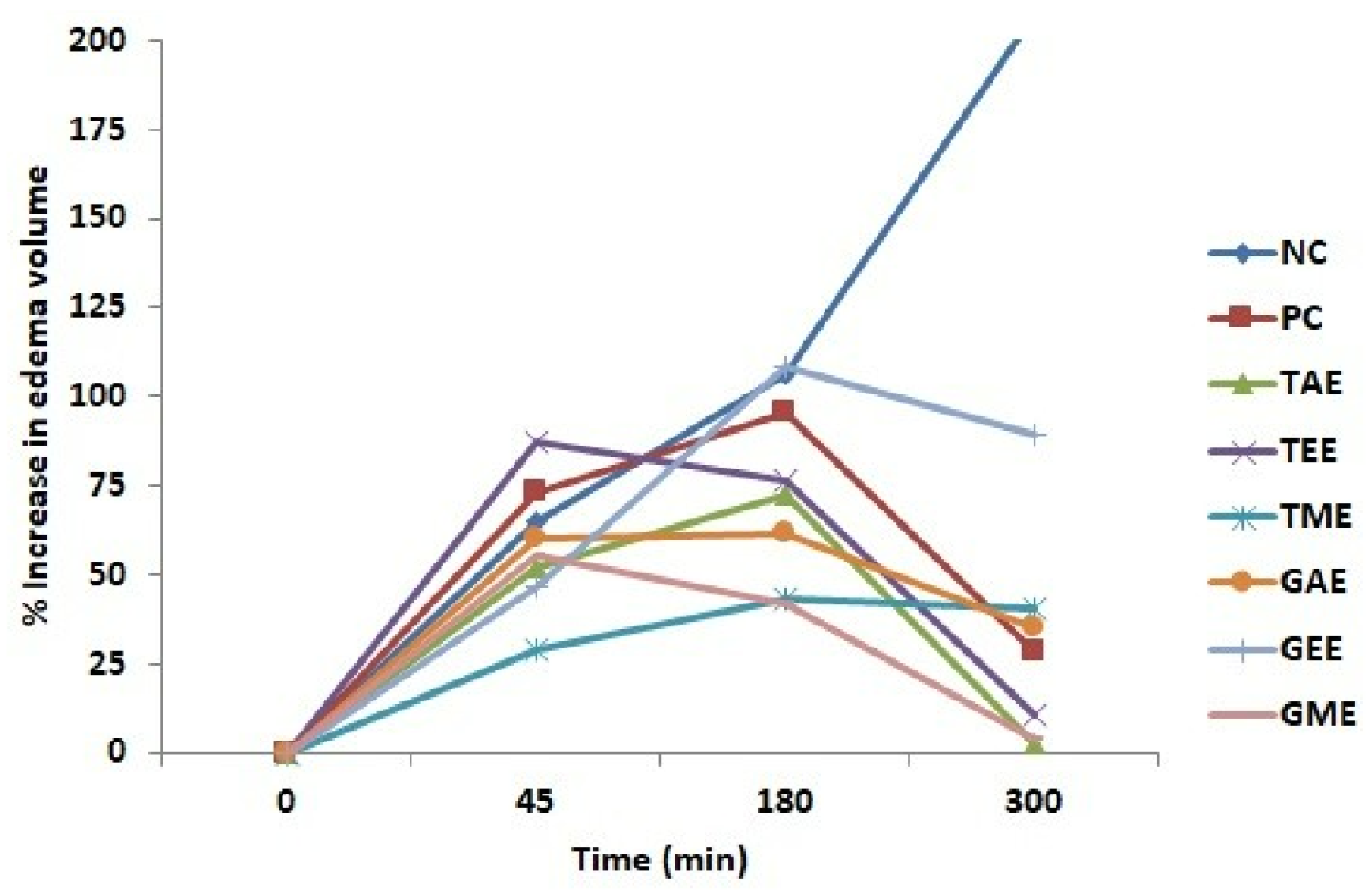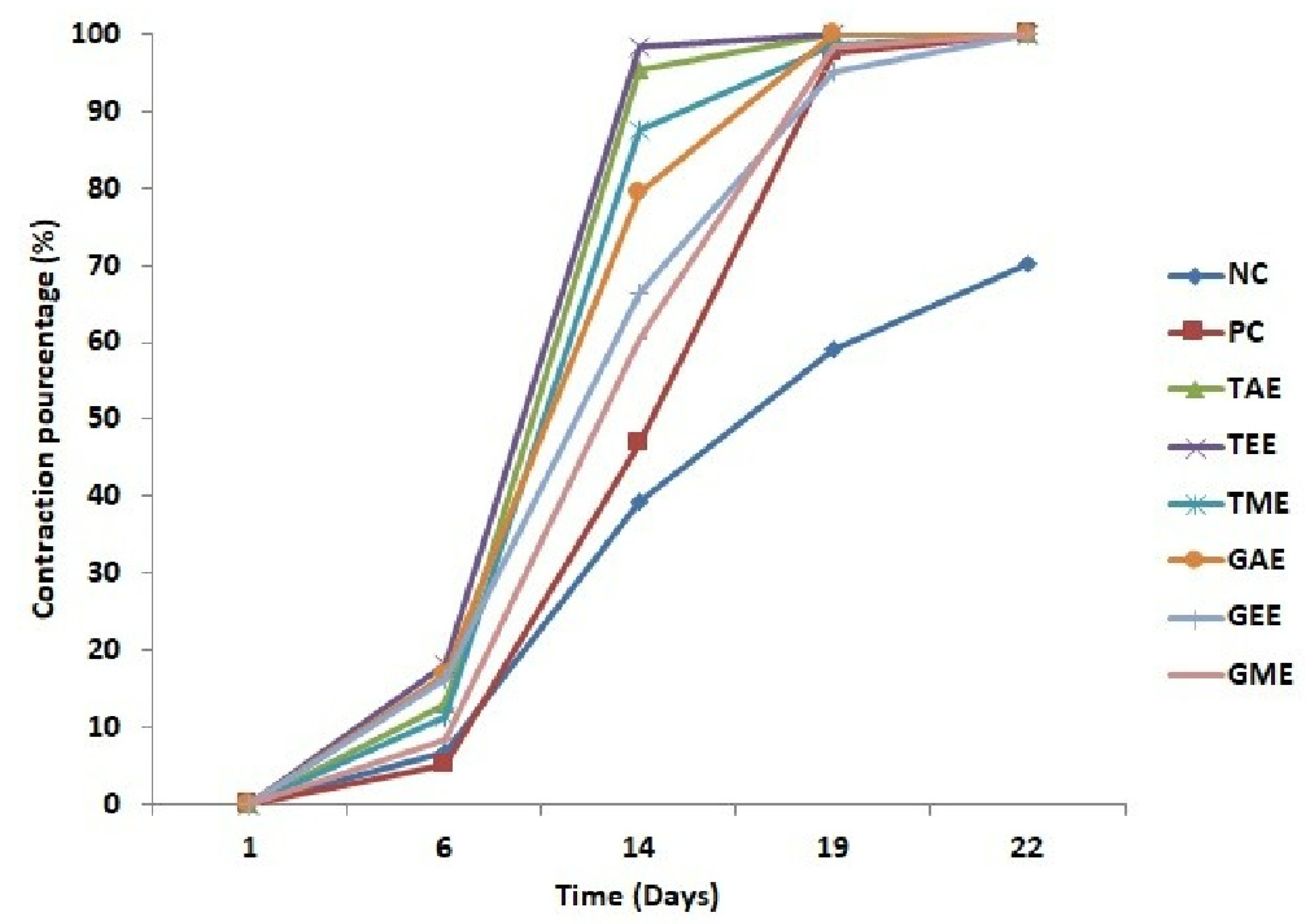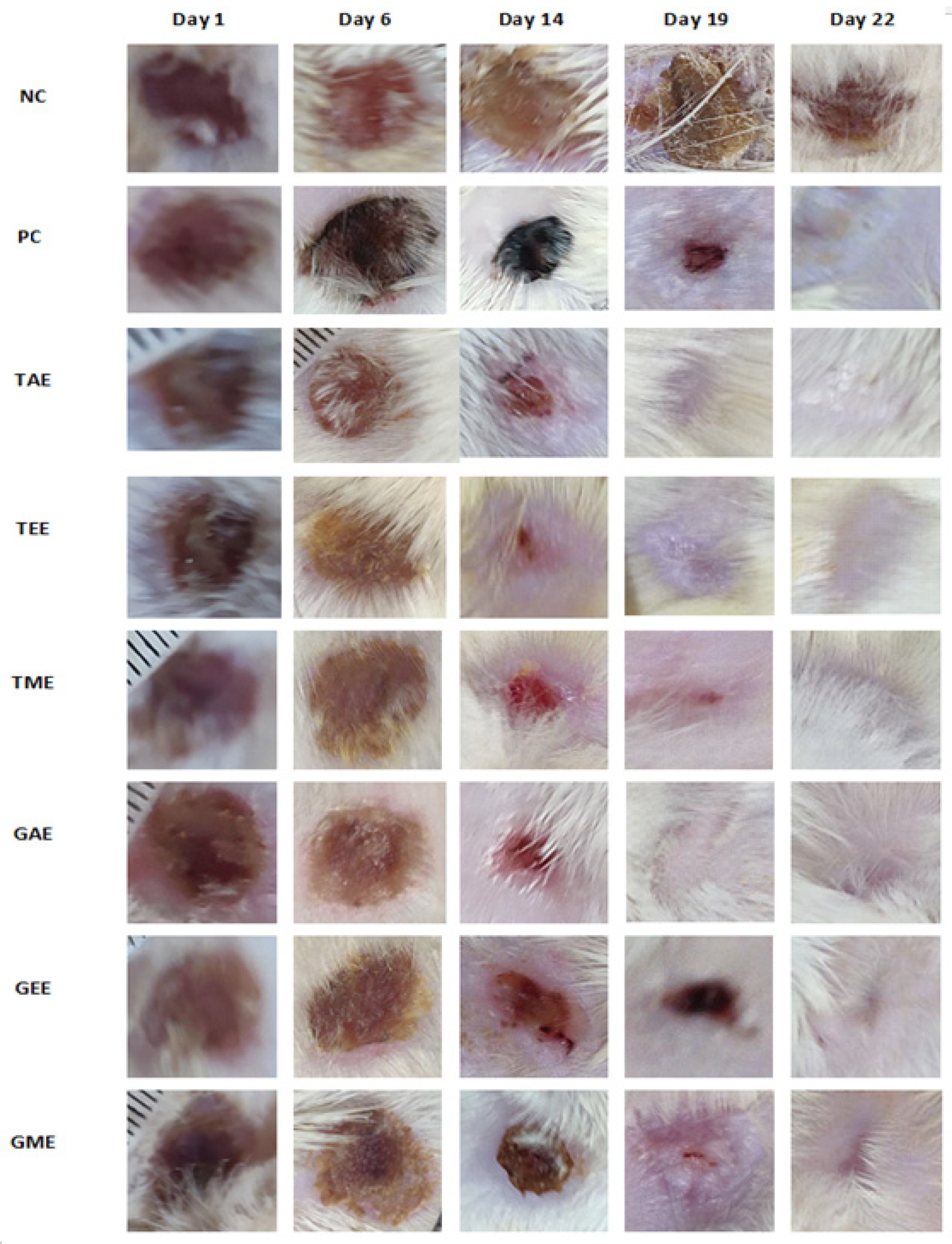Effect of Phenolic Compounds Extracted from Turmeric (Curcuma longa L.) and Ginger (Zingiber officinale) on Cutaneous Wound Healing in Wistar Rats
Abstract
1. Introduction
2. Materials and Methods
2.1. Vegetal Material
2.2. Extracts Preparation
2.3. Animal Model
2.4. Biochemical Study
2.5. Exclusion Chromatography
2.6. Effect of Extracts on Acute Inflammation Induced by 1% Carrageenan in Rats
2.7. Effects of Turmeric and Ginger Rhizome Extracts on Induced Wound Healing in Wistar Rats
2.8. Statistical Analysis
3. Results
3.1. Biochemical and Phytochemical Characteristics of the Studied Spice Extracts
3.2. Gel Filtration Chromatography
3.3. Anti-Inflammatory Activity
3.4. Wound Healing Activity of Turmeric and Ginger Extracts
4. Discussion
5. Conclusions
Author Contributions
Funding
Institutional Review Board Statement
Informed Consent Statement
Data Availability Statement
Acknowledgments
Conflicts of Interest
References
- Najmi, A.; Javed, S.A.; Al Bratty, M.; Alhazmi, H.A. Modern Approaches in the Discovery and Development of Plant-Based Natural Products and Their Analogues as Potential Therapeutic Agents. Molecules 2022, 27, 349. [Google Scholar] [CrossRef] [PubMed]
- Thangapazham, R.L.; Sharad, S.; Maheshwari, R.K. Phytochemicals in Wound Healing. Adv. Wound Care 2014, 5, 230–241. [Google Scholar] [CrossRef] [PubMed]
- Trinh, X.; Long, N.; Van Anh, L.T.; Nga, P.T.; Giang, N.N. A Comprehensive Review of Natural Compounds for Wound Healing: Targeting Bioactivity Perspective. Int. J. Mol. Sci. 2022, 23, 9573. [Google Scholar] [CrossRef] [PubMed]
- Loggenberg, S.R.; Twilley, D.; De Canha, M.N.; Meyer, D.; Mabena, E.C.; Lall, N. Evaluation of Wound Healing and Antibacterial Potential of Greyia Radlkoferi Szyszyl. Ethanolic Leaf Extract. Front. Pharmacol. 2022, 13, 806285. [Google Scholar] [CrossRef] [PubMed]
- Qaswal, A.B. A Theoretical Study to Explain the Referred Pain Phenomenon and Its Characteristics via Quantum Tunneling of Potassium Ions Through the Channels of Neuronal Membrane. NeuroQuantology 2019, 17, 43–52. [Google Scholar] [CrossRef]
- Bouyahya, A.; Guaouguaou, F.; El, N.; El, N.; Balahbib, A.; El-shazly, M.; Bakri, Y. Anti-Inflammatory and Analgesic Properties of Moroccan Medicinal Plants: Phytochemistry, in Vitro and in Vivo Investigations, Mechanism Insights, Clinical Evidences and Perspectives. J. Pharm. Anal. 2022, 12, 35–57. [Google Scholar] [CrossRef]
- Ratan, Z.A.; Jeong, D.; Sung, N.Y.; Shim, Y.Y.; Reaney, M.J.T.; Yi, Y.-S.; Cho, J.Y. LOMIX, a Mixture of Flaxseed Linusorbs, Exerts Anti-Inflammatory Effects through Src and Syk in the NF-κB Pathway. Biomolecules 2020, 10, 859. [Google Scholar] [CrossRef]
- Schilrreff, P.; Alexiev, U. Chronic Inflammation in Non-Healing Skin Wounds and Promising Natural Bioactive Compounds Treatment. Int. J. Mol. Sci. 2022, 23, 4928. [Google Scholar] [CrossRef]
- Criollo-Mendoza, M.S.; Contreras-Angulo, L.A.; Leyva-López, N.; Gutiérrez-Grijalva, E.P.; Jiménez-Ortega, L.A.; Heredia, J.B. Wound Healing Properties of Natural Products: Mechanisms of Action. Molecules 2023, 28, 598. [Google Scholar] [CrossRef]
- Zhou, F.; Hong, Y.; Liang, R.; Zhang, X.; Liao, Y. Rapid Printing of Bio-Inspired 3D Tissue Constructs for Skin Regeneration. Biomaterials 2020, 258, 120287. [Google Scholar] [CrossRef]
- Han, G.; Ceilley, R. Chronic Wound Healing: A Review of Current Management and Treatments. Adv. Ther. 2017, 34, 599–610. [Google Scholar] [CrossRef] [PubMed]
- Okur, M.E.; Karantas, I.D.; Siafaka, P.I. Recent Trends on Wound Management: New Therapeutic Choices Based on Polymeric Carriers. Asian J. Pharm. Sci. 2020, 15, 661–684. [Google Scholar] [CrossRef] [PubMed]
- Karppinen, S.; Heljasvaara, R.; Gullberg, D.; Tasanen, K.; Pihlajaniemi, T. Toward Understanding Scarless Skin Wound Healing and Pathological Scarring [Version 1; Peer Review: 2 Approved]. F1000Research 2019, 8, 787. [Google Scholar] [CrossRef]
- Gonzalez, A.C.d.O.; Costa, T.F.; de Araújo Andrade, Z.; Medrado, A.R.A.P. Wound Healing—A Literature Review *. Bras Dermatol 2016, 91, 614–620. [Google Scholar] [CrossRef]
- Muflihah, Y.M.; Gollavelli, G.; Ling, Y.C. Correlation Study of Antioxidant Activity with Phenolic and Flavonoid Compounds in 12 Indonesian Indigenous Herbs. Antioxidants 2021, 10, 1530. [Google Scholar] [CrossRef]
- Vitale, S.; Colanero, S.; Placidi, M.; Di Emidio, G.; Tatone, C.; Amicarelli, F.; D’Alessandro, A.M. Phytochemistry and Biological Activity of Medicinal Plants in Wound Healing: An Overview of Current Research. Molecules 2022, 27, 3566. [Google Scholar] [CrossRef] [PubMed]
- Mushtaq, Z.; Nadeem, M.T.; Arshad, M.U.; Saeed, F.; Ahmed, M.H.; Bader, H.; Ain, U.; Anjum, F.M.; Hussain, S.; Mushtaq, Z.; et al. Exploring the Biochemical and Antioxidant Potential of Ginger (Adric) and Turmeric (Haldi). Int. J. Food Prop. 2019, 22, 1642–1651. [Google Scholar] [CrossRef]
- Hewlings, S.J.; Kalman, D.S. Curcumin: A Review of Its Effects on Human Health. Foods 2017, 6, 92–98. [Google Scholar] [CrossRef]
- Reeta, V.; Kalia, S. Turmeric: A Review of Its’ Effects on Human Health. J. Med. Plants Stud. 2022, 10, 61–63. [Google Scholar]
- Schaller, T.; Schieberle, P. Comparison of the Key Aroma Compounds in Fresh, Raw Ginger ( Zingiber o Ffi Cinale Roscoe) from China and Roasted Ginger by Application of Aroma Extract Dilution Analysis. J. Agric. Food Chem. 2020, 68, 15292–15300. [Google Scholar] [CrossRef]
- Khan, B.A.; Ullah, S.; Khan, M.K.; Uzair, B.; Menaa, F.; Braga, V.A. Fabrication, Physical Characterizations, and In Vitro, In Vivo Evaluation of Ginger Extract-Loaded Gelatin/Poly(Vinyl Alcohol) Hydrogel Films Against Burn Wound Healing in Animal Model. AAPS PharmSciTech 2020, 21, 323. [Google Scholar] [CrossRef]
- Atanassova, M.; Georgieva, S.; Ivancheva, K. Total Phenolic and Total Flavonoid Contents, Antioxidant Capacity and Biological Contaminants in Medicinal Herbs. J. Univ. Chem. Technol. Metall. 2011, 46, 81–88. Available online: https://journal.uctm.edu/node/j2011-1/12_Maria_Atanasova.pdf (accessed on 9 September 2023).
- Barros, L.; Carvalho, A.M.; Ferreira, I.C.F.R. Exotic Fruits as a Source of Important Phytochemicals: Improving the Traditional Use of Rosa Canina Fruits in Portugal. Food Res. Int. 2011, 44, 2233–2236. [Google Scholar] [CrossRef]
- Lee, H.S.; Castle, W.S. Seasonal Changes of Carotenoid Pigments and Color in Hamlin, Earlygold, and Budd Blood Orange Juices. J. Agric. Food Chem. 2001, 49, 877–882. [Google Scholar] [CrossRef] [PubMed]
- Ahodegnon, D.K.; Gnansounou, M.; Bogninou, R.G.S.; Kanfon, R.; Chabi, B.; Dossa, P.C.A.; Anago, E.A.; Ahoussi, E.; Wotto, V.; Sohounhloue, D.C.K.; et al. Biochemical Profile and Antioxidant Activity of Parkia Biglobosa and Tamarindus Indica Fruits Acclimated in Benin. Int. J. Adv. Res. 2018, 6, 702–711. [Google Scholar] [CrossRef]
- El Massoudi, S.; Zinedine, A.; Rocha, J.M.; Benidir, M.; Najjari, I.; El Ghadraoui, L.; Benjelloun, M.; Errachidi, F. Phenolic Composition and Wound Healing Potential Assessment of Moroccan Henna (Lawsonia Inermis) Aqueous Extracts. Cosmetics 2023, 10, 92. [Google Scholar] [CrossRef]
- Ouda, A.N.; Fatiha, M.; Sadia, M.; Zohra, S.F.; Noureddine, D. In Vivo Anti-Inflammatory Activity of Aqueous Extract of Carthamus Caeruleus L Rhizome Against Carrageenan-Induced Inflammation in Mice. Jordan J. Biol. Sci. 2021, 14, 529–535. [Google Scholar] [CrossRef]
- Mani, R.; Romanelli, M.; Shukla, V. (Eds.) Measurements in Wound Healing; Springer: London, UK, 2013; ISBN 978-1-4471-2986-8. [Google Scholar]
- Bhaskar, A.; Nithya, V. Evaluation of the Wound-Healing Activity of Hibiscus Rosa Sinensis L (Malvaceae) in Wistar Albino Rats. Indian J. Pharmacol. 2012, 44, 694–698. [Google Scholar] [CrossRef]
- Hoşnuter, M.; Gürel, A.; Babucçu, O.; Armutcu, F.; Kargi, E.; Işikdemir, A. The Effect of CAPE on Lipid Peroxidation and Nitric Oxide Levels in the Plasma of Rats Following Thermal Injury. Burns 2004, 30, 121–125. [Google Scholar] [CrossRef] [PubMed]
- Dahmani, S.; Chabir, R.; Errachidi, F.; Berrada, W.; Lansari, H.; Benidir, M.; El Ghadraoui, L.; Bour, A. Evaluation of In Vivo Wound Healing Activity of Moroccan Citrus Reticulata Peel Extract. Clin. Phytoscience 2020, 6, 121–125. [Google Scholar] [CrossRef]
- Asif, A.H.; Mulla, S.M.; Shariff, A.; Sreeharsha, N.; Meravanige, G.; Shiroorkar, P.N.; Mohammed, S.; Asdaq, B.; Anwer, K.; Roopashree, T.S.; et al. Exploring the Topical Gel of Thespesia Populnea Leaf Extract for In Vivo Wound Healing Efficacy. Pharmacogn. Mag. 2022, 13, 519–523. [Google Scholar]
- Chelu, M.; Musuc, A.M.; Popa, M.; Moreno, J.C. Aloe Vera-Based Hydrogels for Wound Healing: Properties and Therapeutic Effects. Gels 2023, 9, 539. [Google Scholar] [CrossRef]
- Jisha, N.; Vysakh, A.; Vijeesh, V.; Latha, M.S. Anti-Inflammatory Efficacy of Methanolic Extract of Muntingia calabura L. Leaves in Carrageenan Induced Paw Edema Model. Pathophysiology 2019, 8, 323–330. [Google Scholar] [CrossRef] [PubMed]
- Rahman, M.M.; Rahaman, M.S.; Islam, M.R.; Rahman, F.; Mithi, F.M.; Alqahtani, T.; Almikhlafi, M.A.; Alghamdi, S.Q.; Alruwaili, A.S.; Hossain, M.S.; et al. Role of Phenolic Compounds in Human Disease: Current Knowledge and Future Prospects. Molecules 2021, 27, 233. [Google Scholar] [CrossRef]
- Bagad, A.S.; Joseph, J.A.; Bhaskaran, N.; Agarwal, A. Comparative Evaluation of Anti-Inflammatory Activity of Curcuminoids, Turmerones, and Aqueous Extract of Curcuma longa. Adv. Pharmacol. Sci. 2013, 2013, 805756. [Google Scholar] [CrossRef] [PubMed]
- Srinivasan, K. Anti-Inflammatory Influences of Culinary Spices and Their Bioactives Anti-Inflammatory Influences of Culinary Spices and Their. Food Rev. Int. 2020, 38, 1–17. [Google Scholar] [CrossRef]
- Pakale, P.V.; Khanwelkar, C.C.; Jadhav, S.A. Study of Anti-Inflammatory Activity of Aqueous and Methanolic Extracts of Dry Powder of Zingiber officinale (SUNTH) in Wistar Rats. Int. J. Health Sci. 2022, 6, 3535–3542. [Google Scholar] [CrossRef]
- Aryal, S.; Baniya, M.K.; Danekhu, K.; Kunwar, P.; Gurung, R.; Koirala, N. Total Phenolic Content, Flavonoid Content and Antioxidant Potential of Wild Vegetables from Western Nepal. Plants 2019, 8, 96. [Google Scholar] [CrossRef]
- Sandhiutami, N.M.D.; Fahleni, F.; Miftahurrohmah, N.; Widhiyasari, N.K.A.; Azalia, A.; Amalia, I. Enhanced Wound Healing Effect of Areca catechu L. Ointment via Antibacterial Activity and Anti-Inflammatory Process at Grade IIA Burns in Rats. J. HerbMed Pharmacol. 2023, 12, 388–398. [Google Scholar] [CrossRef]
- Zulkefli, N.; Che Zahari, C.N.M.; Sayuti, N.H.; Kamarudin, A.A.; Saad, N.; Hamezah, H.S.; Bunawan, H.; Baharum, S.N.; Mediani, A.; Ahmed, Q.U.; et al. Flavonoids as Potential Wound-Healing Molecules: Emphasis on Pathways Perspective. Int. J. Mol. Sci. 2023, 24, 4607. [Google Scholar] [CrossRef]
- Paulraj, M.S.; Rajkumar, S.R.J. Phytochemicals as a Potential Source for Anti- Microbial, Anti-Oxidant and Wound Healing—A Review. MOJ Bioorganic Org. Chem. Rev. 2018, 2, 61–70. [Google Scholar] [CrossRef]
- Epa, C.; Itou, R.E.; Ossibi, A.E.; Attibayeba, O.P.R.; Abena, A.A. Effet Anti-Inflammatoire et Cicatrisant Des Extraits Aqueux et Éthanolique Des Écorces Du Tronc de Buchholzia Coriacea Engl. (Capparidaceae). J. Appl. Biosci. 2015, 94, 8858. [Google Scholar] [CrossRef][Green Version]
- Nagar, H.K.; Srivastava, A.K.; Srivastava, R.; Kurmi, M.L.; Chandel, H.S.; Ranawat, M.S. Pharmacological Investigation of the Wound Healing Activity of Cestrum nocturnum (L.) Ointment in Wistar Albino Rats. J. Pharm. 2016, 94, 8858. [Google Scholar] [CrossRef] [PubMed]
- Deldar, Y.; Pilehvar-soltanahmadi, Y.; Dadashpour, M.; Saheb, M.; Rahmati-yamchi, M.; Zarghami, N. An in Vitro Examination of the Antioxidant, Cytoprotective and Anti-Inflammatory Properties of Chrysin-Loaded Nanofibrous Mats for Potential Wound Healing Applications. Artif. Cells Nanomed. Biotechnol. 2018, 46, 706–716. [Google Scholar] [CrossRef] [PubMed]
- Mishra, S.; Mishra, S.R.; Soni, H. Efficacy of Hydrogel Containing Rutin in Wound Healing. EAS J. Pharm. Pharmacol. 2021, 3, 161–167. [Google Scholar] [CrossRef]
- Seyhan, N. Evaluation of the Healing Effects of Hypericum Perforatum and Curcumin on Burn Wounds in Rats. Evid.-Based Complement. Altern. Med. 2020, 2020, 6462956. [Google Scholar] [CrossRef]
- Sharma, M.; Sahu, K.; Singh, S.P.; Jain, B. Wound Healing Activity of Curcumin Conjugated to Hyaluronic Acid: In Vitro and In Vivo Evaluation. Artif. Cells Nanomed. Biotechnol. 2018, 46, 1009–1017. [Google Scholar] [CrossRef]
- Mohamed, A.H.B.; Osman, A.A.F. Antibacterial and Wound Healing Potential of Ethanolic Extract of Zingiber officinale in Albino Rats Antibacterial and Wound Healing Potential of Ethanolic Extract of Zingiber officinale in Albino Rats. J. Dis. Med. Plants 2021, 3, 1–6. [Google Scholar] [CrossRef]






| Spice | Turmeric | Ginger | ||||
|---|---|---|---|---|---|---|
| Extract | Aq 1 | Eth 2 | Meth 3 | Aq | Eth | Meth |
| Phenolic compounds (mg/100 g DW) | 583.33 | 276.2 | 167.24 | 750.1 | 172.7 | 177.4 |
| Flavonoids (mg/100 g DW) | 116.6 | 82.42 | 71.88 | 63.64 | 26.12 | 15.99 |
| Carotenoids (mg/100 g DW) | 15.89 | 77.80 | 65.84 | 14.82 | 52.13 | 77.88 |
| Vitamin C (mg/100 g DW) | 16.56 | 15.89 | 15.68 | 15.05 | 16.56 | 16.39 |
| Essential oil yield (%) | 1.21 | 0.74 | ||||
Disclaimer/Publisher’s Note: The statements, opinions and data contained in all publications are solely those of the individual author(s) and contributor(s) and not of MDPI and/or the editor(s). MDPI and/or the editor(s) disclaim responsibility for any injury to people or property resulting from any ideas, methods, instructions or products referred to in the content. |
© 2023 by the authors. Licensee MDPI, Basel, Switzerland. This article is an open access article distributed under the terms and conditions of the Creative Commons Attribution (CC BY) license (https://creativecommons.org/licenses/by/4.0/).
Share and Cite
Bouchama, C.; Zinedine, A.; Rocha, J.M.; Chadli, N.; El Ghadraoui, L.; Chabir, R.; Raoui, S.M.; Errachidi, F. Effect of Phenolic Compounds Extracted from Turmeric (Curcuma longa L.) and Ginger (Zingiber officinale) on Cutaneous Wound Healing in Wistar Rats. Cosmetics 2023, 10, 137. https://doi.org/10.3390/cosmetics10050137
Bouchama C, Zinedine A, Rocha JM, Chadli N, El Ghadraoui L, Chabir R, Raoui SM, Errachidi F. Effect of Phenolic Compounds Extracted from Turmeric (Curcuma longa L.) and Ginger (Zingiber officinale) on Cutaneous Wound Healing in Wistar Rats. Cosmetics. 2023; 10(5):137. https://doi.org/10.3390/cosmetics10050137
Chicago/Turabian StyleBouchama, Chaymae, Abdellah Zinedine, João Miguel Rocha, Noureddine Chadli, Lahsen El Ghadraoui, Rachida Chabir, Sidi Mohammed Raoui, and Faouzi Errachidi. 2023. "Effect of Phenolic Compounds Extracted from Turmeric (Curcuma longa L.) and Ginger (Zingiber officinale) on Cutaneous Wound Healing in Wistar Rats" Cosmetics 10, no. 5: 137. https://doi.org/10.3390/cosmetics10050137
APA StyleBouchama, C., Zinedine, A., Rocha, J. M., Chadli, N., El Ghadraoui, L., Chabir, R., Raoui, S. M., & Errachidi, F. (2023). Effect of Phenolic Compounds Extracted from Turmeric (Curcuma longa L.) and Ginger (Zingiber officinale) on Cutaneous Wound Healing in Wistar Rats. Cosmetics, 10(5), 137. https://doi.org/10.3390/cosmetics10050137








